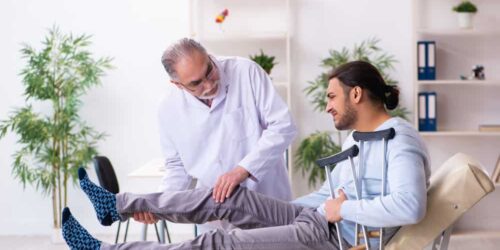With the growth of desk jobs, screen time, and lifelong poor posture, more people are experiencing upper cross syndrome (UCS). Sometimes called upper crossed syndrome (that’s an academic debate), UCS can become debilitating and cause pain in your upper thoracic (upper back), shoulders, and neck. You can probably spot it yourself if you see a person with rounded or hunched shoulders, a head that sits in front of the body, and a curvature of the neck and upper back.
We’re not talking the Quasimodo (the hunchback of Notre Dame) here. That’s a different thing called Scheuermann’s disease. However, upper cross syndrome without correction can manifest itself into a permanent postural hunch, also referred to as dowager’s hump. It’s a combination of poor posture, weak muscles, and low bone density in the upper spine.
We know what you’re thinking… I’m waaaay to young to be worried about upper cross syndrome. Well, don’t worry, but be informed. As you stare at Instagram for 20 minutes, connecting with co-workers or virtual school on Zoom, entering data into a spreadsheet on your laptop, your posture takes a beating. Even athletes who are quite active can have UCS.
So, enough talk, let’s move on.
What is upper cross syndrome?
The muscles throughout your body are all interconnected in some way or another. That makes up the musculoskeletal component of us humans. When one muscle weakens, another muscle takes on the job to make up for it. With poor posture, you’ve got mid-back muscles (the lower trapezius and serratus, for you anatomy folks) that weaken. Poor posture also weakens the rhomboid and neck muscles while tightening and shortening the pectoral and upper trapezius muscles (that’s where the “cross” comes from). So, your trapezius and pectoral muscles tighten up to help correct the weakened muscles in your lower back. With UCS, you’ve got a muscle imbalance happening in your mid to upper back. So, when your traps and pecs tighten, it generally causes neck pain, shoulder pain, and your range of motion becomes reduced. Remember, it’s musculoskeletal. One works in unison with the other! With this muscular imbalance, your joints get out of whack causing pain. That’s upper cross syndrome.
Causes and symptoms of upper cross syndrome?
While we’ve covered several potential causes, prolonged poor posture and sedentary lifestyle are the major causes for upper cross syndrome. Long durations of sitting, looking down staring at screens or too much computer time can cause this imbalance. Also, athletes who potentially build strong trapezoids and pecs (ie. swimmers), can experience UCS.

- Tight neck or neck pain
- Headaches
- Upper back pain
- Lack of chest and shoulder mobility (ie. range of motion becomes limited)
- At times, numbness, tingling sensation, and pain in the arms especially closer to your shoulders and pecs
How do you treat upper cross syndrome?
UCS is very treatable before chronic posture issues set in. The muscle imbalance causes your vertebrae to get torqued and twisted, sending nerve signals to your brain that something’s out of whack. Mobility, flexibility, and spinal adjustments are generally some of the most effective treatments for UCS. By combining regular stretching, strengthening the weak muscles, corrective posture management, and adjustments, many of the issues related to upper cross syndrome can be addressed. At Pro-Care, we offer SMART Sessions, which combines a treatment protocol focused on surrounding muscles, soft tissue, AND skeletal alignment.
In the meantime, make lifestyle adjustments if needed. Five ways to help your posture today:
- If you have a desk job or your kid’s in virtual school, set alarms on your phone to stand and stretch for a few minutes after 20-30 minute increments of sitting
- Set screentime limits on your phone, especially for the apps that are time sucks for you
- Adjust your desk to ensure you are sitting or standing with good posture
- Invest in a standing desk if possible to have the ability to move from sitting or standing throughout the day
- Do a posture check in the mirror. Where are your shoulders and back?
Also, here are SIX exercises you can do to help adjust your posture and strengthen you upper back, neck, and shoulders to reduce the likelihood of upper cross syndrome causing you issues. You can find these and more Pro-Care Protocols here!




